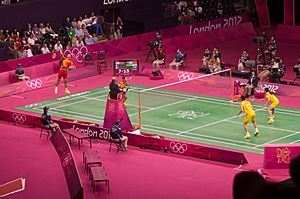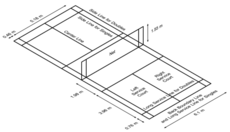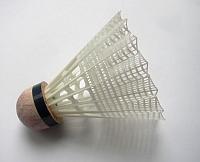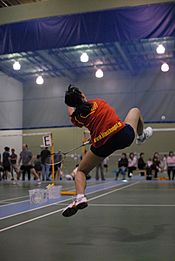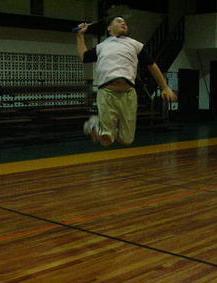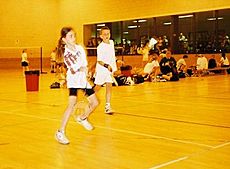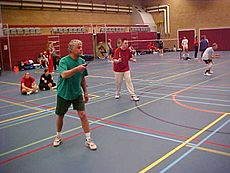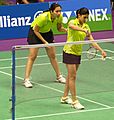Badminton facts for kids
Badminton is a sport that uses racquets to hit a shuttlecock (also called a birdie) over a net. A shuttlecock is a feathered or (in informal matches) plastic projectile that flies differently from a ball. The feathers cause the shuttlecock to slow down much more quickly than a ball.
Players serve the birdie and hit it over the net. Each side may only hit the shuttlecock once before it passes over the net. The first team to land it on the ground of the opposing team's side of the court scores a point. The most common forms of badminton are "singles" (with one player per side) and "doubles" (with two players per side).
The game became popular in British India from the earlier game of battledore and shuttlecock. It has been an Olympic sport since 1992 with five events: men's singles, women's singles, men's doubles, women's doubles, and mixed doubles.
Contents
History


Games using shuttlecocks have been played for centuries across Eurasia, but the modern game of badminton became more popular during the mid-1800s among the British. They changed an earlier game called battledore and shuttlecock. ("Battledore" was an older term for "racquet.") Its exact origin remains unknown. The name comes from the Duke of Beaufort's Badminton House in Gloucestershire.
The game may have originally developed among British officers living in British India, where it was very popular by the 1870s. It was played in the town of Pune, where the rules were written. By 1875, returning officers had started a badminton club in Folkestone. Several changes were made to the rules until 1893 when the Badminton Association of England (BAE) published the rules and officially began the sport.
More countries joined together to form the International Badminton Federation in 1934: England, Scotland, Wales, Canada, Denmark, France, Ireland, the Netherlands, and New Zealand. This group is now known as the Badminton World Federation. More countries have joined since then: India, China, Denmark, India, Indonesia, Malaysia, and South Korea are among them.
The game has also become a popular backyard sport in the United States.
Rules
The following information is a simplified summary of badminton rules based on the BWF Statutes publication, Laws of Badminton:
Court
The court is rectangular and divided into halves by a net. Courts are usually marked with lines for both singles and doubles play. The doubles court is wider than the singles court, but both are of the same length. The serving line is closer to the net for doubles play.
The full length of the court is 44 ft (13.4 m). The full width of the court is 20 ft (6.1 m), which is used in doubles' play. The width for singles' play is 17 ft (5.18 m). There is a line drawn down the center of the court which divides the width of the court in half. Servers have to serve diagonally across this center line and over the net to their opponent.
The net is 5 ft 1 in (1.55 m) high at the edges and 5 ft (1.524 m) in the center. The posts for the net are placed over the doubles sideline, even when singles is played.
The minimum height for the ceiling above the court is not mentioned in the Laws of Badminton. Players should try to play with a high ceiling so they can hit the ball high without hitting the ceiling.
Serving
When the server serves, the shuttlecock must pass over the short service line on the opponents' court or it will count as a fault.
To begin the rally (the term for hitting the shuttlecock back and forth), the server and receiver stand in diagonally opposite service courts. The server hits the shuttlecock so that it would land in the receiver's service court. This is similar to tennis, but there are a few differences: The badminton serve must be hit below waist height. The racquet shaft (the part of the racquet between the head and the handle) must be pointing downward, and the shuttlecock is not allowed to bounce. Players stand inside their service courts.
When the serving side loses a rally, the serve immediately passes to their opponent(s). In singles, the server stands in their right service court when their score is even, and in her/his left service court when her/his score is odd.
In doubles, if the serving side wins a rally, the same player continues to serve, but he/she changes service courts so that she/he serves to a different opponent each time. If the opponents win the rally and their new score is even, the player in the right service court serves; if odd, the player in the left service court serves.
Scoring
Each game is played to 21 points, with players scoring a point whenever they win a rally, no matter who the serving team was. A match is the best of three games.
If the score reaches 20-all (meaning tied at 20-20), then the game continues until one side gains a two-point lead (such as 24–22), except when there is a tie at 29-all, in which the game goes to a golden point. Whoever scores this point will win.
There are two ways to determine which team serves first in the first game:
- A shuttlecock toss: the side to which the shuttlecock points after it lands is the side that serves.
- A coin toss: A team calls one side of a coin as it is flipped into the air. If the coin lands with the called side showing, they win the coin toss. If the coin lands with the other side showing, the other team wins the coin toss.
In the following games, the winners of the previous game serve first. For the first rally of any doubles game, the serving pair may decide who serves and the receiving pair may decide who receives. The players change ends at the start of the second game; if the match reaches a third game, they change ends both at the start of the game and when the leading player's or pair's score reaches 11 points.
The server and receiver must remain within their service courts, without touching the boundary lines, until the server hits the shuttlecock. The other two players may stand wherever they wish, as long as they do not block the vision of the server or receiver.
Lets
Sometimes play is stopped and no score is given. This is called a let. Lets happen when there is an unexpected disturbance in the game, like another team's shuttlecock landing in the court or the shuttlecock touching a ceiling or rail.
If the receiver is not ready when the service is delivered, a let can be called. However, if the receiver tries to return the shuttlecock, a let will not be called because the receiver was aware of the serve.
Equipment
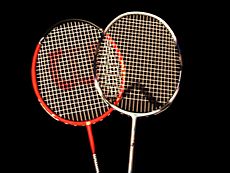
Badminton rules restrict the design and size of racquets and shuttlecocks.
Racquets
Badminton racquets are lightweight, with top-quality racquets weighing between 2.5 and 3.4 ounces (70 and 95 grams). They are made of many different materials ranging from carbon fiber composite (graphite reinforced plastic) to solid steel. Previously, racquets were made of aluminum or wood. Nowadays, nanomaterials such as fullerene and carbon nanotubes are added to racquets to make them more durable.
There is a wide variety of racquet designs, although the laws limit the racquet size and shape. The traditional oval head shape is still available, but an isometric head shape is now more common in new racquets.
Strings
Badminton strings are thin, high-performing strings with thicknesses ranging from about 0.62 to 0.73 mm. Thicker strings are more durable, but many players prefer the feel of thinner strings. String tension is normally higher on the racquets of professional players than on the racquets of recreational players.
Some people think higher string tensions improve control while lower string tensions increase power. Others believe the opposite. Neither view has been proven through testing. The best way for a player to find a good string tension is to experiment for himself.
Grip
Grip is a material that looks similar to cloth tape. It is used to increase the thickness of a racquet handle and make the racquet more comfortable to hold.
There are two main types of grip: replacement grips and overgrips. Replacement grips are thicker and are often used to increase the size of the handle. They have a sticky backing like a roll of tape. Many players choose to use replacement grips without an overgrip.
Overgrips are thinner (less than 1 mm) and are often used as the final layer. They only have a small patch of adhesive (stickiness) at the start of the tape. Overgrips are stretchy and stay on the handle because they are applied under tension. They are more convenient for players who change grips more often because of sweat or discomfort.
Shuttlecock
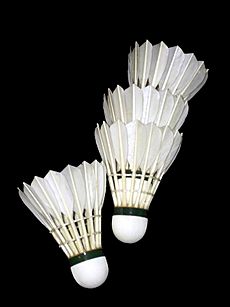
A shuttlecock (often abbreviated to shuttle; also called a birdie) is a high-drag projectile, with an open conical shape: the cone is formed from sixteen overlapping feathers implanted into a rounded cork base. The cork is covered with thin leather or synthetic material. These nylon shuttles may be constructed with either natural cork or synthetic foam base and a plastic skirt. Recreational players often use synthetic shuttles because feathered shuttles are expensive and break easily.
Shoes
Badminton shoes are lightweight with soles of rubber or similar high-grip, non-marking materials.
Because badminton requires more lateral (sideways) motion than most sports, shoes with lateral support should not be used. They encourage weaker ankles and the support can suddenly give out on the shoe, which causes sprains. Instead, shoes should have a very thin sole and no lateral support. Proper technique and footwork, as well as strong ankles, go a long way in preventing injury in the game of badminton.
Technique
Strokes
All badminton strokes can be hit either forehand or backhand. A player's forehand side is the same as their playing hand: for a right-handed player, the forehand side is their right side and the backhand side is their left side. Forehand strokes are hit with the palm of the hand facing the net, and backhand strokes are hit with the back of the hand facing the net. Usually, forehand strokes are more powerful than backhand strokes. However, players should not always use power. Slower speeds and proper aim can win a point as well. Serves are required to be hit with the racquet head being lower than the racquet handle.
Position of the shuttlecock and receiving player
The choice of stroke depends on how near the shuttlecock is to the net, how high the shuttlecock is when it is hit, and where the opponent is positioned on the court. The closer to the net the opponent is, the more likely he is to hit the shuttlecock with a hard overhand hit like a net kill, smash, or jump smash. Players can still hit the shuttlecock with an overhand hit in the rear court (the part of the court furthest from the net), but they cannot hit it downward like they can in the forecourt or midcourt.
Vertical position of the shuttlecock
When the shuttlecock is well below net height, players have no choice but to hit upward. This hit is called a lift and can be played from all parts of the court.
When the shuttlecock is near net height, players have two choices. They can hit drives, which hit the shuttlecock straight over the net. Drives are more powerful than pushes, which gently push the shuttlecock over the net.
Spin
Although a shuttlecock does not bounce like a tennis ball would, it can still be sliced (hit with an angled racquet face) to change its direction to confuse opponents. A shuttlecock can be sliced from different sides to cause it to curve and slow down more suddenly. When a shuttlecock is sliced from underneath, it may turn over itself (tumble) several times, causing the opponent to wait until the shuttle has corrected itself before he hits it.
Due to the way that its feathers overlap, a shuttlecock also has a slight, natural counter-clockwise spin. This natural spin affects certain strokes.
Biomechanics
Badminton biomechanics has not been studied thoroughly, but some studies show how the wrist and rotations of the different parts of the arm affect power shots.
The feathers of the shuttlecock cause drag, making the shuttlecock decelerate (slow down) quickly. If a player wants to hit the shuttlecock the full length of the court, it would require a powerful hit.
The shuttlecock is also extremely aerodynamically stable: regardless of initial orientation, it will turn to fly cork-first and remain in the cork-first orientation. When it is hit very high, the shuttlecock may even fall vertically.
Deception
Once players have mastered these basic strokes, they can use other movements to deceive their opponents. Slicing causes the shuttlecock to move more slowly than the arm movement suggests. Some players can brush the strings around the shuttlecock during the hit to make the shuttlecock spin.
The light weight of modern racquets allows players to use a very short hitting action for many strokes.
- Players can keep their arm fairly still and still hit a powerful shot.
- Players can also make it look like they are going to hit a power shot and then do a light flick of the wrist if they notice the opponent is ready for a power shot.
- Players can use double motion, where they make an initial racquet movement in one direction, stop that movement, and hit in another direction. Triple motion is possible but very rare.
- Players can use a racquet head fake, where the initial motion is continued but the racquet is turned during the hit, causing the shuttle to go in a different direction.
Strategy
To win in badminton, players need to use a wide variety of strokes in the right situations. Deception is also an important strategy when playing badminton.
Singles
Since one person needs to cover the entire court, one strategy players use is to force their opponent to move as much as possible. They place their shots in different areas of the court. Smashing happens less often in singles than in doubles because it is harder for a player to hit a shuttlecock that is returned right after a smash.
Doubles
In doubles play, both pairs will try to gain and keep the attacking position, smashing downward whenever they can. Sometimes both players need to play in the middle to defend against an attack from the other team. In doubles, players usually try to smash between the two opponents to create confusion.
In high levels of play, the backhand serve has become popular. The rallies are extremely fast. Men's doubles is the most aggressive form of badminton, with the most powerful jump smashes and very quick reflex changes. Because of this, there are more fans of men's doubles than of singles.
Mixed doubles
In mixed doubles, both pairs typically try to maintain an attacking formation with the woman at the front of the court and the man at the back. This is because the male players are usually much stronger and can therefore hit more powerful smashes. Clever opponents will try to reverse the ideal position by forcing the woman toward the back or the man toward the front. To protect against this danger, mixed players must be careful in their shot selection.
Organization
Governing bodies
The Badminton World Federation (BWF) is the internationally recognized governing body of the sport responsible for the conduction of tournaments and ensuring fair play. Five regional confederations are associated with the BWF:
- Asia: Badminton Asia Confederation (BAC)
- Africa: Badminton Confederation of Africa (BCA)
- Americas: Badminton Pan Am (North America and South America belong to the same confederation; BPA)
- Europe: Badminton Europe (BE)
- Oceania: Badminton Oceania (BO)
Competitions
The BWF organizes several international competitions, including the Thomas Cup for men, the Uber Cup for women, and the Sudirman Cup for gender-mixed teams.
Badminton was a demonstration event in the 1972 and 1988 Summer Olympics. It became an official Summer Olympic sport at the Barcelona Olympics in 1992.
There are four levels of badminton tournaments:
- Level-one tournaments include the Thomas, Uber, and Sudirman Cups, the Olympics, and the BWF World (and World Junior Championships).
- Level-two tournaments are in the BWF Super Series. Among the tournaments in this series is the respected All-England Championships, first held in 1900, which was once considered the unofficial world championships of the sport.
- Level-three tournaments consist of the Grand Prix Gold and Grand Prix events.
- Level-four tournaments, known as International Challenge, International Series, and Future Series, encourage participation by junior players.
Comparison with tennis
Badminton is frequently compared to tennis. The following is a list of differences:
- Scoring:
- In badminton, a match is played best 2 of 3 games. Each game is played to 21 points. Play must continue until one team gets a two-point advantage. At 29–all, whoever scores the golden point will win.
- In tennis, a match is played best of 3 or 5 sets, with each set consisting of 6 games. Each game ends when one player wins 4 points or wins 2 consecutive deuce points. If the score is tied 6–6 in a set, a tiebreaker will be played. The first player to 7 points or to get a two-point advantage wins.
- Shuttlecock/Ball
- In badminton, the rally ends when the shuttlecock touches the floor.
- In tennis, the ball may bounce once before the rally ends.
- Serving:
- In badminton, the server has far less advantage: serves in badminton are easier to return. An unreturnable serve (ace) is rare. The player has one chance to hit a serve into the service box.
- In tennis, the server is expected to win most of the games he serves. The player has two chances to hit a serve into the service box.
- Stroke speed:
- In badminton, the fastest stroke during gameplay was Lee Chong Wei's 253 mph (407 km/h) recorded smash at the 2015 Hong Kong Open.
- In tennis, the fastest recorded stroke is Samuel Groth's 163.4 mph (263 km/h) serve.
- Court:
- A tennis court is approximately twice the length and width of a badminton court.
- Weight of equipment:
- Tennis racquets are about four times as heavy as badminton racquets, 10 to 12 oz (280 to 340 g) versus 2 to 3 oz (57 to 85 g).
- Tennis balls are more than eleven times heavier than shuttlecocks, 2 oz (57 g) versus 0.175 oz (5.0 g).
- Technique:
- In badminton, the light weight of the shuttlecock and racquet allows players to use their wrist and fingers when swinging the racquet. Strokes are shorter than tennis strokes.
- In tennis, the wrist is normally held stable. Tennis strokes are longer than badminton strokes.
Interesting facts about badminton
- Badminton is the second-most popular sport in the world. (Soccer is the first.)
- The Badminton World Federation has over 150 member nations.
- Badminton racquets are not allowed to touch the net during play.
- The world's largest shuttlecock is located on the lawn of the Kansas City Art Museum. This shuttle is 18 feet tall and weighs nearly three tons.
- Austrian players Mario Langmann and Thomas Paulweber hold the Guinness World Record for playing the longest marathon badminton match: 25 hours 25 minutes and 44 seconds.
- The shortest badminton match lasted only six minutes. It was played in 1966 at the Uber Cup in Hong Kong between South Korean Ra Kyung-min and British player Julia Mann.
- The best badminton shuttlecocks are made from 16 feathers of only the left wing of a goose.
- A shuttlecock is often referred to as a birdie.
- The first Olympic badminton match broadcasted on television was watched by 1.1 billion viewers.
- Indonesia and China have won 70% of all Badminton World Federation events.
Images for kids
-
Malaysian player Lee Chong Wei smashing
-
Korean players Lee Yong-dae and Ko Sung-hyun defend against a smash
-
Indonesian player Praveen Jordan showing a loose grip before smashing
-
Indian women players Ashwini Ponnappa and Jwala Gutta at 2010 BWF World Championships
-
Spanish Beatriz Corrales at the 2015 Finnish Open Badminton Championships in Vantaa, Finland
See also
 In Spanish: Bádminton para niños
In Spanish: Bádminton para niños


